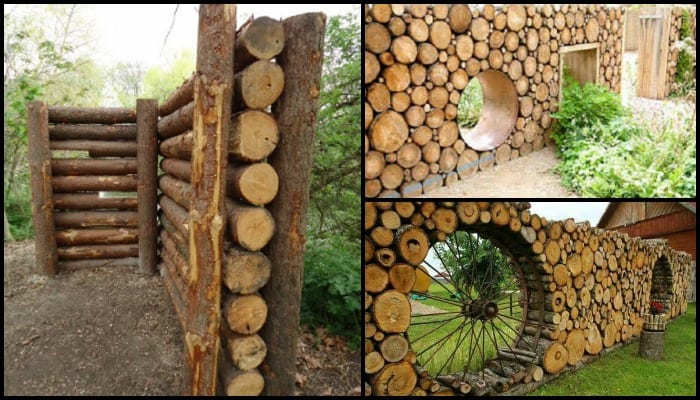
Are you looking for ways to add privacy to your yard? A unique fence is one way to achieve this. Here’s an interesting idea for a fence that you might want to consider!
It’s an inexpensive project for those living near or out in the woods. It’s also a great option for those who want a truly unique design. You can create images/portraits with it (like these), allowing for curvy layouts!

Contents
Cordwood Fence Basics
A log-end, stack wood, or cordwood fence is a type of fence made from logs or wood pieces that are stacked on top of each other. The logs or wood pieces can be of any size or thickness, and the fence can be of any height. There are various ways to build a log-end, stack wood, or cordwood fence, and your chosen method will depend on your preferences and the area you’re fencing in.
A log-end fence is a great option if you’re looking for a rustic look. A stack wood fence may be a better choice if you’re looking for a more modern look. It all depends on your location, design preference, budget, and type of wood available to you.
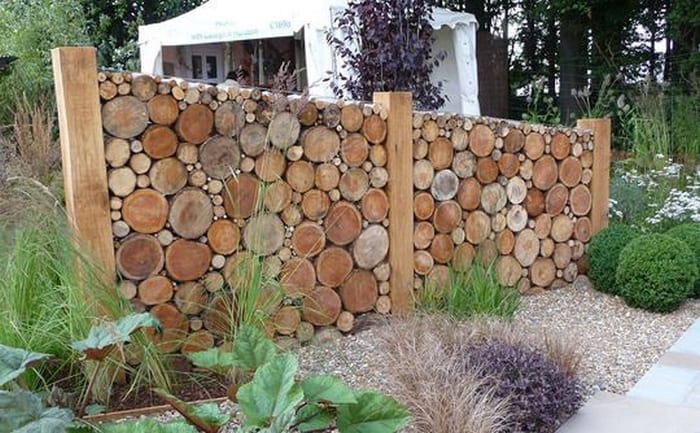
If you are going for a really strong and permanent kind, then you can build one with the use of mortar, just like the walls of these cordwood homes.
If you are unsure about whether or not you will need to remove the cordwood fence in the future, dry stacking may be the better option for you. This way, you can avoid damaging the wood by taking it out and potentially having to replace it. This method of construction is sometimes called puzzle log construction, as the logs fit together like pieces of a puzzle.
The logs are placed on top of each other, with the ends of the logs interlocking. This type of construction does not use mortar for reinforcement, as the logs themselves provide structural support. Cordwood construction has been used for centuries and is still in use today in some parts of the world.
This type of construction is well-suited to areas with an abundance of timber, as no other materials are needed. Puzzle log construction is also a very sustainable form of construction, as the logs can be sourced from renewable forests. This is also the best option for those living in moist or rainy areas as mortar/concrete tends to trap moisture and speed up the decaying process of wood.
Now, regardless of where you are and what exact building method you use, it is important to always use rot-resistant wood for this cordwood fence project! Cedar, Osage Orange, Redwood, and Black Locust are some of the best choices for rot-resistant wood.
This is because they are all naturally resistant to rot and decay, and will therefore last much longer than other types of wood. If you’re looking for a hardwood that’s sure to stand the test of time, bois d’arc is a great option. This wood is one of the hardest available, making it ideal for a cordwood fence where durability is key. Plus, its natural beauty is sure to add a touch of elegance to any space.
Building a Cordwood Fence
Materials Needed for a Cordwood Fence
- Rot-resistant wood (e.g., Cedar, Osage Orange, Redwood, Black Locust)
- Mortar mix (if using mortar method)
- Concrete or gravel (for the foundation)
- Wood preservative or sealer
Tools Required
- Saw (for cutting wood to size)
- Trowel (for applying mortar)
- Level (to ensure even stacking)
- Shovel (for preparing the site and foundation)
- Safety gear (gloves, goggles, dust mask)
- Measuring tape
- String and stakes (for marking the fence line)
- Wheelbarrow (for mixing mortar and moving materials)
Instructions
Planning Your Cordwood Fence
Before you start, it’s crucial to plan. Decide on the location, length, and height of your fence. Consider the type of wood you’ll use and whether you’ll use mortar or opt for a dry stack method. Gather all necessary tools and materials.
Gathering Materials
You’ll need rot-resistant wood like Cedar, Osage Orange, Redwood, or Black Locust. If using mortar, prepare a mix according to the manufacturer’s instructions. Ensure you have all tools, including a saw, trowel, level, and safety gear.
Preparing the Site
Clear the fence line of any debris, rocks, or vegetation. Mark the outline of your fence with stakes and string to ensure straight lines. Dig post holes at the corners and along the fence line as needed for support.
Building the Foundation
A solid foundation is key for a durable cordwood fence. Pour a concrete footing or lay a gravel base to prevent wood from touching the ground directly, reducing the risk of rot.
Stacking the Wood
Start stacking your wood pieces on the foundation. If using mortar, apply it between each layer of wood, ensuring even coverage. For a dry stack, carefully place each piece of wood so it fits snugly against its neighbors. Use a level to keep the fence straight.
Finishing Touches
Once you’ve reached the desired height, finish the top of the fence with a solid beam or capstone to protect the wood ends from weather. If you’ve used mortar, clean off any excess and smooth the joints for a polished look.
What do you think about this fence idea? Well, if you are interested, have a look at some examples from our album below for cordwood fence design ideas and be inspired to build your own! 🙂
Is this the perfect cordwood fence for your yard?
Click on any image to start the lightbox display. Use your Esc key to close the lightbox. ![]()

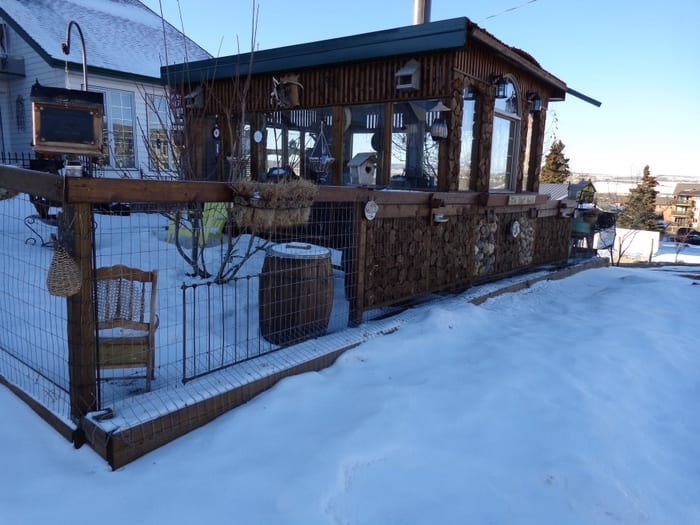
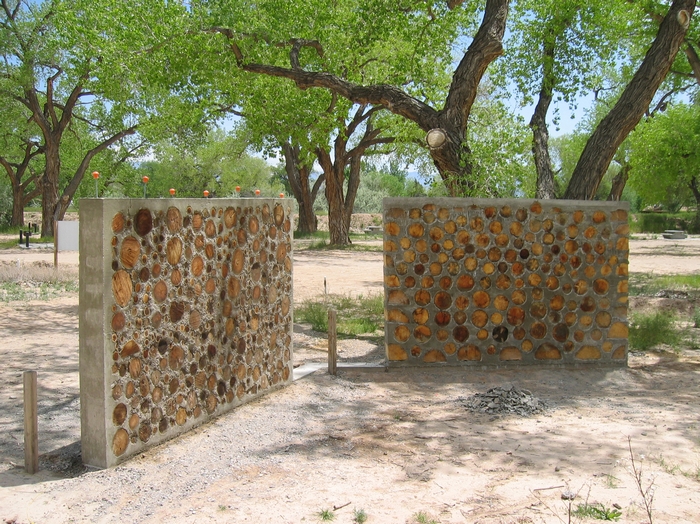
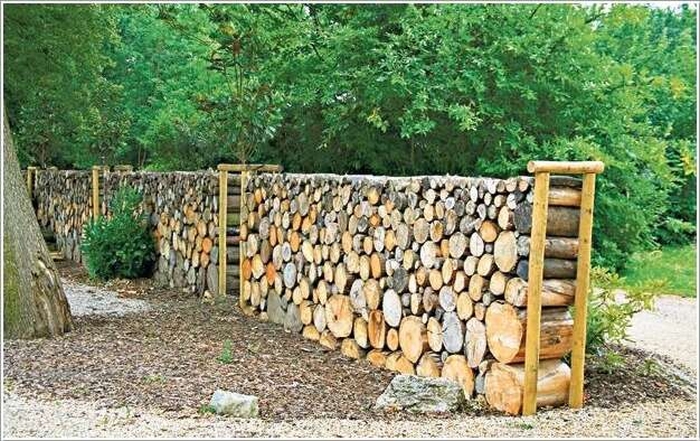
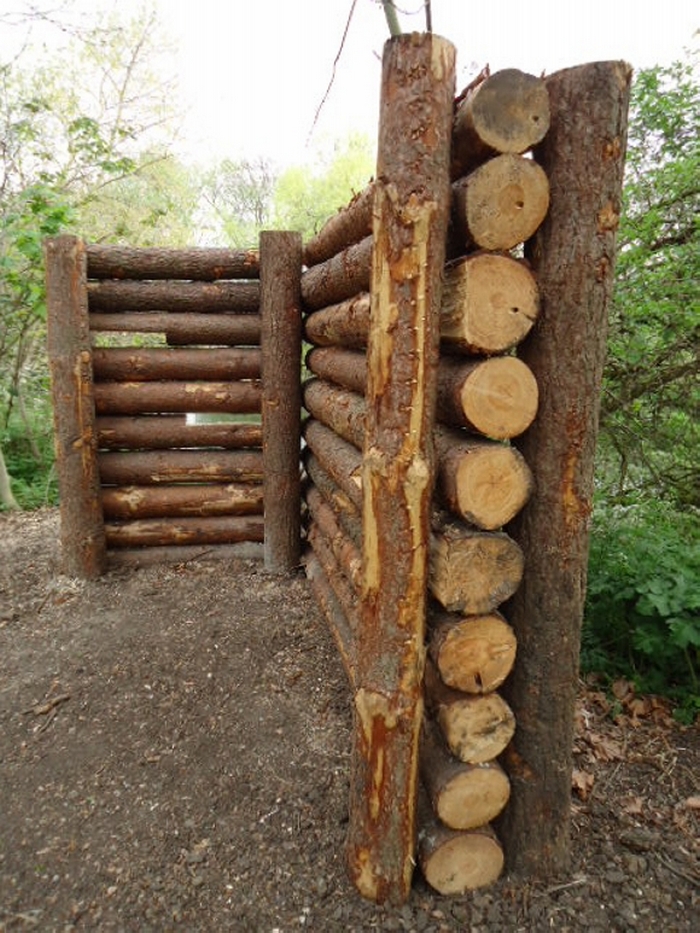
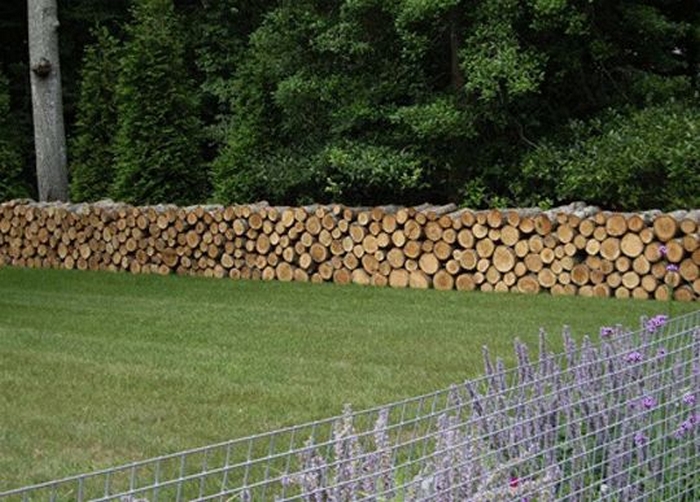
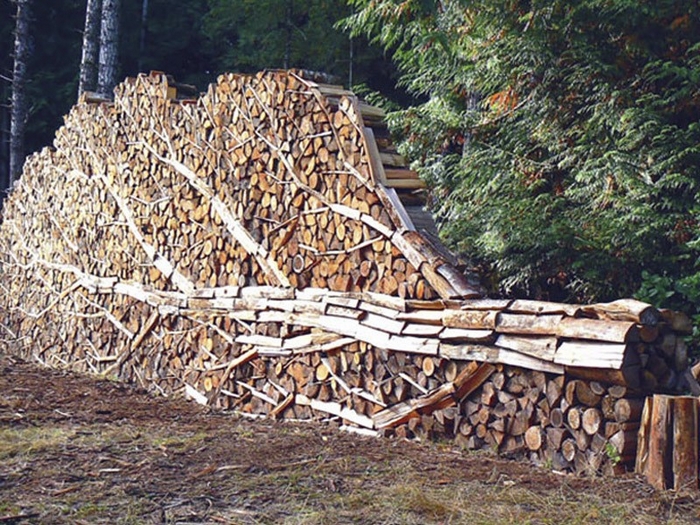
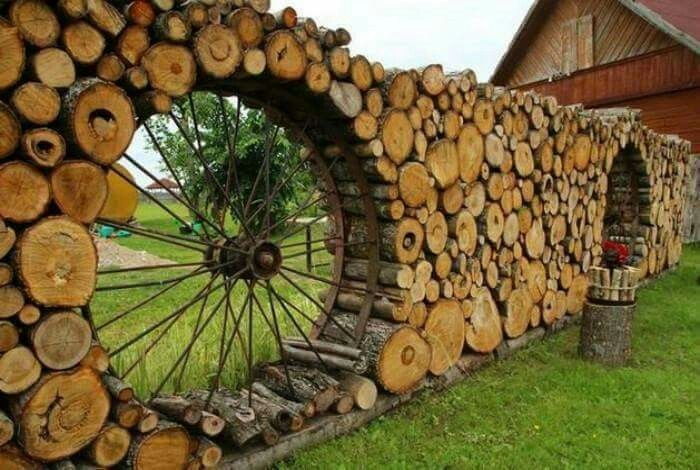

Choosing the Right Wood for Your Cordwood Fence
Choosing the right wood for your cordwood fence is vital for its durability, appearance, and resistance to decay. This decision impacts the fence’s lifespan and maintenance needs. Here’s how to select the best wood for your project.
Understand Your Climate
Climate is crucial in determining the best wood for your cordwood fence. Woods such as Cedar and Redwood thrive in moist conditions thanks to their inherent rot resistance. These types of wood contain natural oils and compounds that protect them against mold, mildew, and decay, making them ideal for regions with high humidity or frequent rainfall.
On the other hand, dryer climates demand woods that can withstand less moisture without deteriorating. Osage Orange and Black Locust are excellent choices for these conditions. They are known for their hardness and durability, capable of enduring the sun’s intense heat and the occasional dry spells without cracking or weakening.
Choosing the right wood based on your local climate ensures your cordwood fence remains strong and beautiful for years, minimizing the need for frequent repairs or replacements.
Consider Wood Availability
The availability of wood in your area significantly influences your choice for a cordwood fence. Opting for locally sourced wood offers several benefits. First, it’s often more affordable than importing wood from distant locations. Transportation costs can add up, making locally available wood a more budget-friendly option.
Second, using local wood is better for the environment. It reduces the carbon emissions associated with long-distance transportation, contributing to a lower overall environmental footprint of your fencing project.
Furthermore, local woods are adapted to your region’s climate, ensuring a better fit for your cordwood fence in terms of durability and performance. Supporting local businesses and sustainable forestry practices also strengthens your community’s economy and conservation efforts. By choosing readily available wood in your region, you’re making a cost-effective, environmentally responsible, and community-supportive decision.
Evaluate Rot Resistance
When selecting wood for your cordwood fence, assessing the rot resistance of different wood types is crucial. This property determines how well the wood can withstand elements such as moisture, insects, and fungi over time.
Cedar and Redwood stand out for their exceptional natural rot resistance, making them excellent choices for areas prone to dampness. These woods contain oils and tannins that repel water and pests, effectively slowing down the decay process.
Osage Orange and Black Locust are also highly resistant to rot, suited for varying climates due to their dense and hard nature. These woods are especially valuable in dryer regions, where their durability and strength ensure the fence’s longevity.
Choosing a wood with high rot resistance significantly enhances the durability and lifespan of your cordwood fence, ensuring it remains a beautiful and functional part of your yard for many years.
Aesthetic Preferences
The availability of suitable wood types within your region is key in planning your cordwood fence project. Opting for locally sourced wood makes your project more cost-effective and reduces its environmental impact.
Local woods are adapted to your area’s climate and conditions, ensuring your cordwood fence is built with material inherently suited to withstand local weather patterns and pests. This choice supports local economies and sustainable forestry practices, promoting a healthier environment by minimizing the carbon emissions of transporting materials over long distances.
Additionally, using local wood can offer unique aesthetic options that reflect the natural beauty of your surroundings. In choosing readily available wood for your cordwood fence in your region, you embrace a practical, eco-friendly, and community-supportive approach.
Sustainability
When planning your cordwood fence, prioritizing sustainability in your wood selection can significantly minimize the environmental impact of your project. Choosing sustainably harvested wood ensures that the materials used for your fence come from forests managed in a way that maintains their biodiversity, productivity, and ecological processes. This approach supports long-term forest management practices that prevent overharvesting, promote reforestation, and safeguard wildlife habitats.
Opting for reclaimed wood is another sustainable choice for your cordwood fence. Reclaimed wood comes from deconstructed buildings, old barns, or other structures, repurposing materials that would otherwise contribute to waste. This not only reduces the demand for new lumber, preserving forest resources but also decreases landfill waste, making your fencing project more environmentally friendly.
Legal Considerations for Building a Cordwood Fence
Before embarking on your cordwood fence project, it’s essential to understand the legal considerations and permissions required. Navigating these requirements ensures your project complies with local regulations, helping avoid potential legal issues or fines.
Check Local Zoning Laws
Before starting the construction of your cordwood fence, it’s imperative to familiarize yourself with the local zoning laws that might affect your project. These laws are established to maintain the community’s safety, aesthetics, and overall harmony.
They often dictate the permissible height, location, setbacks from property lines, and sometimes even the materials and design of fences. For example, certain areas may restrict the maximum height of a backyard or front yard fence or prohibit certain materials for aesthetic or environmental reasons.
To ensure your cordwood fence project aligns with these regulations, make a visit to your local zoning office or check their official website for comprehensive guidelines. Gathering this information early in the planning stage is key. It helps prevent potential legal issues from unintentionally violating local ordinances.
Sometimes, special approvals or variances may be required if your project doesn’t fit standard regulations. Understanding these nuances before you begin construction on your cordwood fence ensures a smoother process and helps avoid costly modifications.
Obtain Necessary Permits
Securing the necessary permits is a critical step in the process of building a cordwood fence. This requirement is common in many municipalities and serves several purposes, including ensuring the safety and structural integrity of your fence and maintaining the community’s aesthetic standards. The permit application process allows local authorities to review your project plans in advance, ensuring they comply with local building codes and zoning regulations.
To obtain a permit, you’ll typically need to submit detailed plans of your cordwood fence, including its dimensions, materials, design, and location on your property. This might also involve showing how your fence will be constructed and demonstrating that it will not encroach on property lines or easements. Some localities might require additional documentation or approvals, especially if your property is in a historic district or a similar special zoning area.
Starting your cordwood fence project without the necessary permits can lead to several complications. These might include being ordered to halt construction, remove or modify the fence at your expense, or even facing fines.
Therefore, visiting your local building department or their website is crucial to understand the specific requirements for fence construction permits in your area. This step ensures that your cordwood fence project proceeds without legal hurdles, securing your investment and peace of mind.
Consider Property Lines
Determining the exact location of your property lines is a crucial step before beginning construction on your cordwood fence. Building even a small section of your fence on a neighbor’s property can lead to significant legal disputes, costly resolutions, and strained neighborly relations. These disputes often require the removal and possible relocation of the fence, doubling the effort and expense.
If your property boundaries are unclear or there’s any uncertainty, it’s wise to hire a professional surveyor. A surveyor can accurately map your property lines, ensuring your cordwood fence is built entirely within your legal boundaries.
This prevents potential legal issues and maintains harmony with your neighbors by respecting shared boundaries. Moreover, a professional survey can provide legal documentation of your property’s boundaries, which can be invaluable in resolving any future disputes over land use or ownership.
Review HOA Guidelines
Living in a community governed by a homeowners’ association (HOA) means adhering to its set of rules and guidelines, especially when modifying your property with structures like fences. HOAs typically enforce specific regulations concerning fence styles, heights, materials, and even colors to ensure a uniform and pleasing aesthetic within the community. These rules are designed to preserve property values and the neighborhood’s overall look.
Before starting your cordwood fence project, thoroughly review your HOA’s guidelines. This might involve consulting the community’s bylaws, speaking with the HOA board, or reviewing the covenant conditions and restrictions document. Non-compliance with these rules can lead to demands for alterations to or removal of your fence, additional fines, or other penalties imposed by the HOA.
Adherence to HOA guidelines from the planning stage of your cordwood fence ensures that your project proceeds smoothly and is ultimately successful. Getting approval from your HOA before beginning construction avoids potential conflicts and ensures that your fence will enhance your home’s and community’s overall value and appeal.
FAQ on Building a Cordwood Fence
What is a cordwood fence?
A cordwood fence is a type of fence made by stacking logs or pieces of wood (cordwood) on top of each other, often with the ends facing out. It can be built with or without mortar.
Why choose a cordwood fence for my yard?
Cordwood fences are unique, environmentally friendly, and can be cost-effective, especially if you have access to free or low-cost wood. They also offer excellent privacy and can be designed in various creative ways.
What types of wood are best for a cordwood fence?
Rot-resistant woods like Cedar, Osage Orange, Redwood, and Black Locust are ideal for cordwood fences. These woods last longer and resist decay and pests.
Do I need a permit to build a cordwood fence?
Yes, in many areas, you’ll need a permit. Always check with your local building department or zoning office for requirements before you start building.
How do I prepare the site for a cordwood fence?
Clear the area of debris, rocks, and vegetation. Mark your fence line with stakes and string, and consider the location of any underground utilities.
Can I build a cordwood fence on any type of ground?
Yes, but you may need to adjust your foundation method. For example, areas with high moisture might require a gravel base for drainage, while other areas might be suitable for a direct ground foundation.
Conclusion
Building a cordwood fence is a rewarding project that combines aesthetics, privacy, and sustainability. By carefully selecting the right wood, adhering to legal requirements, and considering the unique needs of your landscape, you can create a durable and beautiful fence that stands the test of time. Remember to plan thoroughly, respect your local environment and community standards, and maintain your fence to ensure it remains a valued addition to your property.








